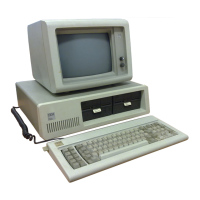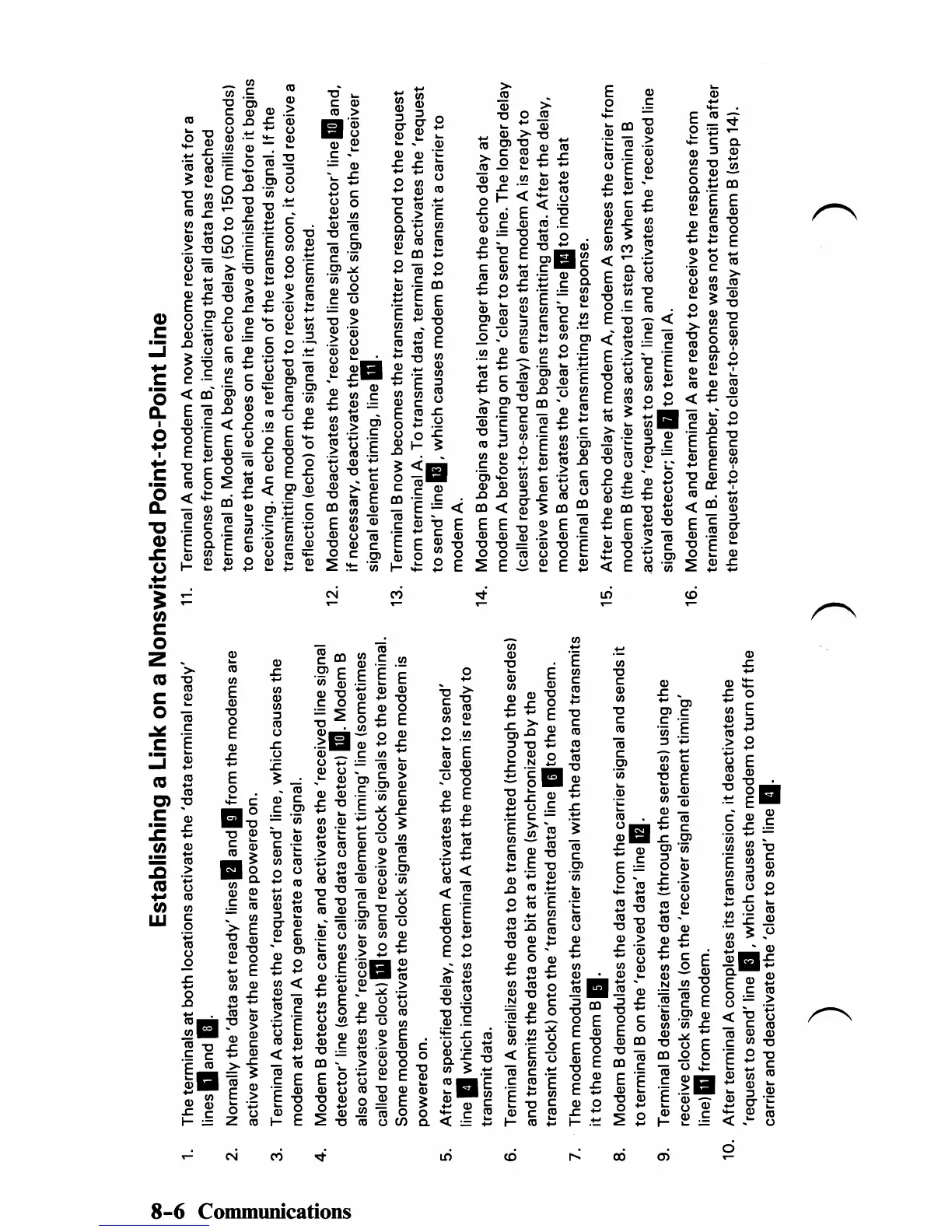I
CIC
Establishing a
link
on
a Nonswitched Point-to-Point
line
~
1.
The terminals at
both
locations
activate
the
'data
terminal ready'
~
lineslland
D.
~
2.
Normally
the
'data
set
ready'
lines.
and
II
from
the
modems are
active whenever
the
modems
are
powered
on.
S.
3.
Terminal A activates
the
'request
to
send' line,
which
causes
the
&$
modem
at
terminal A
to
generate a carrier signal.
§
~
4.
Modem B detects
the
carrier, and activates
the
'received line signal
[Il
detector'
line (sometimes called data carrier
detect)
l1li.
Modem
B
also activates the
'receiver
signal
element
timing'
line (sometimes
called receive clock)
lito
send receive
clock
signals
to
the
terminal.
Some modems
activate
the
clock
signals
whenever
the
modem is
powered on.
S.
After
a specified delay, modem A activates
the
'clear
to
send'
line.
which
indicates
to
terminal A
that
the
modem
is ready
to
transmit
data.
6. Terminal A serializes
the
data
to
be
transmitted
(through
the
serdes)
and transmits the data one
bit
at
a
time
(synchronized
by
the
transmit
clock)
onto
the
'transmitted
data'
line
lito
the
modem.
7. The modem modulates
the
carrier signal
with
the
data and
transmits
it
to
the
modem B II.
8. Modem B demodulates
the
data
from
the carrier signal and sends
it
to
terminal B on
the
'received
data'
line
lEI.
9. Terminal B deserializes
the
data (through
the
serdes) using
the
receive clock signals (on
the
'receiver
signal element
timing'
line)
II
from the modem.
10.
After
terminal A completes
its
transmission,
it
deactivates
the
'request
to
send' line
II,
which
causes
the
modem
to
turn
off
the
carrier and deactivate
the
'clear
to
send' line
II.
)
11.
Terminal A and modem A
now
become receivers and
wait
for
a
response
from
terminal
B,
indicating
that
all data has reached
terminal
B.
Modem A begins an echo delay
(SO
to
1S0 milliseconds)
to
ensure
that
all echoes on
the
line have diminished
before
it
begins
receiving.
An
echo is a reflection
of
the
transmitted
signal.
If
the
transmitting
modem changed
to
receive
too
soon,
it
could receive a
reflection (echo)
of
the signal
it
just
transmitted.
12.
Modem
B deactivates
the
'received line signal
detector'
linelland,
if
necessary, deactivates
the
receive clock signals on
the
'receiver
signal element timing, line II.
13. Terminal B
now
becomes
the
transmitter
to
respond
to
the
request
from
terminal A. To
transmit
data, terminal B activates
the
'request
to
send'
line.,
which
causes
modem
B
to
transmit
a carrier
to
modemA.
14.
Modem
B begins a delay
that
is longer than
the
echo
delay
at
modem
A before
turning
on
the
'clear
to
send' line.
The
longer delay
(called request-to-send delay) ensures
that
modem A is ready
to
receive
when
terminal B begins
transmitting
data.
After
the
delay,
modem
B activates
the
'clear
to
send'
line
lito
indicate
that
terminal B can begin
transmitting
its
response.
1S.
After
the
echo delay
at
modem A, modem A senses
the
carrier
from
modem B (the carrier
was
activated
in step 13
when
terminal
B
activated
the
'request
to
send' line) and activates
the
'received
line
signal detector;
lineD
to
terminal A.
16.
Modem
A and terminal A are ready
to
receive
the
response
from
termianl
B.
Remember,
the
response
was
not
transmitted
until
after
the
request-to-send
to
clear-to-send delay
at
modem B (step 14).
) )

